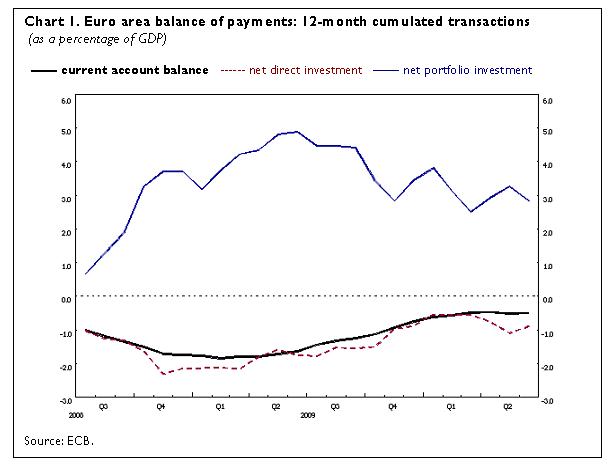Euro area balance of payments in June 2010
In June 2010 the seasonally adjusted current account of the euro area recorded a deficit of EUR 4.6 billion. In the financial account, combined direct and portfolio investment recorded net outflows of EUR 4 billion (non-seasonally adjusted).
Current account
The seasonally adjusted current account of the euro area recorded a deficit of EUR 4.6 billion in June 2010 (see Table 1). This reflected deficits in current transfers (EUR 7.8 billion) and income (EUR 1.6 billion), which were partly offset by surpluses in goods (EUR 2.6 billion) and services (EUR 2.2 billion).
The 12-month cumulated seasonally adjusted current account recorded a deficit of EUR 45.1 billion in June 2010 (around 0.5% of euro area GDP – see Table 1), compared with a deficit of EUR 147.9 billion a year earlier. The reduction in the current account deficit was due to a shift in goods from deficit (EUR 10.2 billion) to surplus (EUR 45.2 billion), an increase in the surplus in services (from EUR 29.7 billion to EUR 35.6 billion), and to decreases in the deficits in income (from EUR 70.2 billion to EUR 34.5 billion) and current transfers (from EUR 97.2 billion to EUR 91.3 billion).

Financial account
In the financial account (see Table 2), combined direct and portfolio investment recorded net outflows of EUR 4 billion in June 2010, as the net outflows in direct investment (EUR 7 billion) exceeded the net inflows in portfolio investment (EUR 3 billion).
The net outflows in direct investment resulted predominantly from net outflows in other capital (mostly inter-company loans) (EUR 11 billion).
Portfolio investment recorded net inflows in equity (EUR 16 billion), mainly reflecting net purchases of euro area equity by non-residents (EUR 19 billion), which were to a large extent offset by net outflows in debt instruments (EUR 13 billion).
Financial derivatives recorded net inflows of EUR 1 billion.
Other investment recorded net inflows of EUR 1 billion, reflecting net inflows in other sectors (EUR 18 billion) which were almost totally offset by net outflows in the Eurosystem (EUR 12 billion), and in MFIs excluding the Eurosystem (EUR 6 billion). The general government account was close to balance.
The Eurosystem’s stock of reserve assets was EUR 583 billion at the end of June 2010. Transactions in June 2010 contributed to a decrease of EUR 1 billion in the overall position.
In the 12-month period to June 2010, combined direct and portfolio investment recorded cumulated net inflows of EUR 174 billion, compared with net inflows of EUR 285 billion in the preceding 12-month period. This decrease was the result of lower net inflows in portfolio investment (down from EUR 443 billion to EUR 254 billion), which were partly offset by lower net outflows in direct investment (down from EUR 159 billion to EUR 81 billion). The decrease in net inflows in portfolio investment was due mainly to lower net inflows in debt instruments (down from EUR 487 billion to EUR 209 billion) that were partly counterbalanced by a shift from net outflows (EUR 44 billion) to net inflows (EUR 45 billion) in equity.
Data revisions
This press release incorporates revisions to the data for May 2010. These revisions have resulted in higher net outflows in other investment (from EUR 27 billion to EUR 33 billion) and lower net outflows in direct investment (from EUR 17 billion to EUR 12 billion).
Additional information on the euro area balance of payments and international investment position
In this press release, the seasonally adjusted current account refers to working day and seasonally adjusted data. Data for the financial account are non-working day and non-seasonally adjusted.
In line with the agreed allocation of responsibilities, the European Central Bank compiles and disseminates monthly and quarterly balance of payments statistics for the euro area, whereas the European Commission (Eurostat; see “Euro-indicators” new releases) focuses on quarterly and annual aggregates for the European Union. These data comply with international standards, particularly those set out in the IMF’s Balance of Payments Manual (fifth edition). The aggregates for the euro area and the European Union are compiled consistently on the basis of transactions and positions with residents of countries outside the euro area and the European Union respectively.
A complete set of updated euro area balance of payments (including a quarterly geographical breakdown by main counterparts) and international investment position statistics is available in the “Statistics” section of the ECB’s website under the headings “Data services”/“Latest monetary, financial markets and balance of payments statistics”. These data, as well as historical euro area balance of payments time series, can be downloaded from the ECB’s Statistical Data Warehouse (SDW). Data up to June 2010 will also be published in the September 2010 issues of the ECB’s Monthly Bulletin and Statistics Pocket Book. Detailed methodological notes are available on the ECB’s website. The next press release on the euro area monthly balance of payments will be published on 17 September 2010.
Annexes
Table 1: Current account of the euro area
Table 2: Monthly balance of payments of the euro area
Europeiska centralbanken
Generaldirektorat Kommunikation och språktjänster
- Sonnemannstrasse 20
- 60314 Frankfurt am Main, Tyskland
- +49 69 1344 7455
- media@ecb.europa.eu
Texten får återges om källan anges.
Kontakt för media

